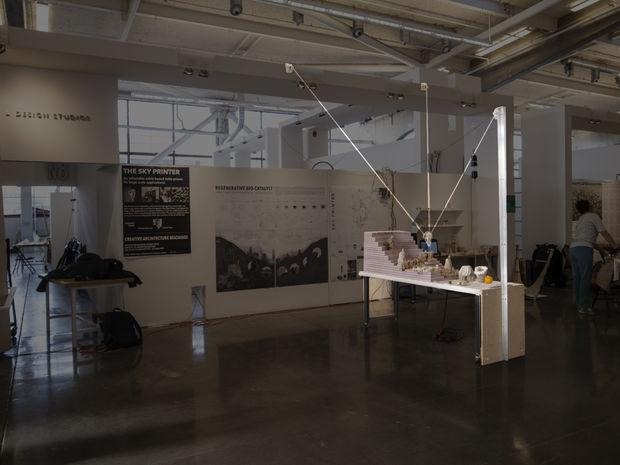Results 1 to 5 of 5
Thread: The Sky 3D Printer
-
12-18-2014, 07:51 AM #1
The Sky 3D Printer
Two architectural students from California College of the Arts in San Francisco have made an ingenious design with the Sky Printer, a 3D printer meant to print on a large scale in remote locations. Using cable suspension for the printing nozzle which has no actual platform to reach, their original intent is to use the 3D printer with clay as a material. While its uses should be expansive, the architects also see it as being useful in space, canyons, and anywhere there is a large vertical space for it to operate in. Check out more details: http://3dprint.com/31502/student-arc...s-sky-printer/
Below is a photo of the Sky Printer setup:

-
12-18-2014, 08:27 AM #2Staff Engineer

- Join Date
- Dec 2013
- Location
- Georgia
- Posts
- 934
Okay, when the print head is moving, how does it stop to turn a corner precisely without swinging slightly on the strings? And slight swinging is all it needs to get bizarre ripples in every part of the printed piece. Also, even architects should know that a wire hanging even a large weight at an angle will still sag, the position of the print head will be unpredictable to within a few millimeters on this setup, let alone in a canyon, where wind will have a hanging weight swinging around a radius of about half a foot.
It's not like engineers haven't thought of this, they just thought of the reasons it won't work well before making nice images and trying to claim it as a great idea.
At least it's better conceived than putting an extruder on a quadcopter and thinking it will be a flying printer...
-
12-18-2014, 11:38 AM #3Engineer-in-Training

- Join Date
- Oct 2014
- Posts
- 314
If they're talking about using clay as the print material it's likely that mm precision is not the goal. Given the size of the nozzle shown in the article further reduces the need for that kind of precision.
Swaying of the print head would be determined by the rigidity of the cables used. Three points of control is technically enough to keep the print head stable but if one or more cables bends due to compressive loads that could result in swaying. Keeping the cables highly tensioned and using stiff cables would prevent or at least minimize this. Keeping the print head as light as possible would also minimize swaying since it wouldn't have enough inertia to compress the cables.
Lastly, sag is certainly going to occur but it can be calculated fairly if not extremely accurately and compensated for from there.
I'm certainly not suggesting that all these things have been accounted for in their design, but the issues you bring up, while certainly real, are not necessarily insurmountable.
-
12-19-2014, 12:23 AM #4Student

- Join Date
- Dec 2014
- Posts
- 1
A few notes... This idea was shared on a Deltabot forum months ago... and they had one incredible addition that helps with the sharp corners for faster printing... the addition of a "super gravity pole."
Imagine have a pole pushing down on the effector. The downward force will greatly improve the rigidity and sideways acceleration. The easiest way to get a large downward force on this pole is to add weight on the top, but you don't want that weight to move during effector moves, or you will not have gained.
Two possible solutions are to keep the weight fixed in the center, but that may still have rotational inertia, or even better and easier, attach the weight to a pole, possibly through a spring which also adds a more constant force during high accelerations.
Another version of this super gravity pole is available for a printer in a room... In this case an expandable pole is anchored at the top center, and the string is routed through pulleys to create the expanding downward force.
TriDPrinting.com is actively working on an open source version of this style of printer with a pole.
-
12-19-2014, 08:22 AM #5Staff Engineer

- Join Date
- Dec 2013
- Location
- Georgia
- Posts
- 934
While sag is predictable, it leads to bouncing when the line is extended or retracted. And you're very right that the precision is unnecessary when printing with a big line of clay, but look at it scaled up to the size of a canyon like they are dreaming of. Those lines are going to have to increase in diameter and weight, the inaccuracy that they introduce will be multiplied as well, the small scale printer might have error of a few millimeters, but try keeping steady aim on something from the middle of a cable bridge to feel how unsteady it is even without trying to move the ends around.
In order to even make a continuous wall, you'd need a bead of clay a foot across, and it will look ugly.
The Gravity Bar idea might have some merit to it, though you may also look at a project from a year ago that is very similar to this that uses six anchor points to provide rigidity, three driven lines and three that are anchored to constant-force springs (could just as easily have used counterweights, really) https://designmakeshare.wordpress.co...cing-skydelta/






 Reply With Quote
Reply With Quote




QIDI Slicer "Plater" is...
04-12-2024, 02:21 AM in QiDi 3D Printer Forum